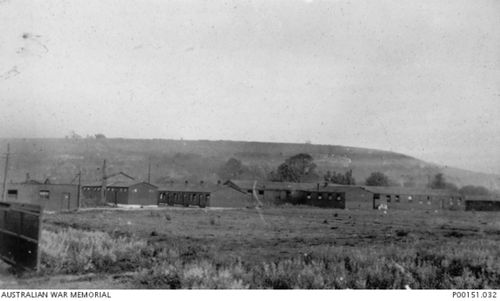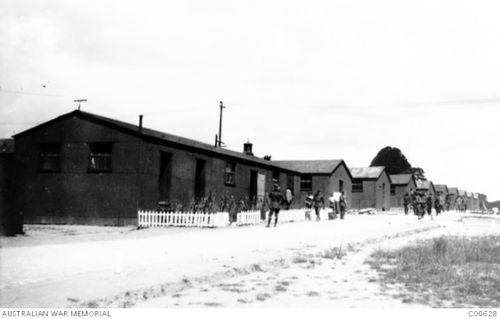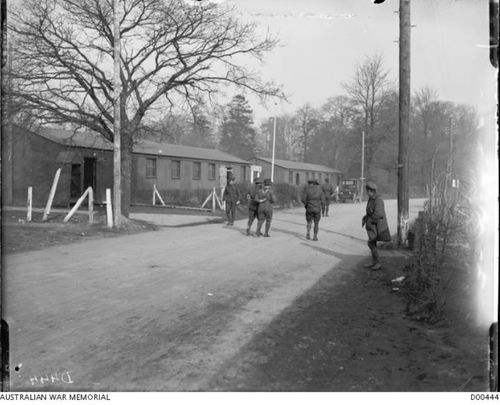Difference between revisions of "Hurdcott"
From Our Contribution
(→Soldiers who passed this way) |
(→Soldiers who passed this way) |
||
| Line 63: | Line 63: | ||
* [[John Alexander Spilsbury]] Oct 1917 - May 1918 | * [[John Alexander Spilsbury]] Oct 1917 - May 1918 | ||
* [[Robert Frank Bickford]] 12 Nov 1917 - 15 Mar 1918 - No. 3 Command Depot | * [[Robert Frank Bickford]] 12 Nov 1917 - 15 Mar 1918 - No. 3 Command Depot | ||
| + | * [[Frederick Robert Weedon]] 2 Oct 1917 - 11 Nov 1917 | ||
* † [[Frederick James Powell]] ?? Nov 1917 - 7 Feb 1918 - No. 3 Command Depot | * † [[Frederick James Powell]] ?? Nov 1917 - 7 Feb 1918 - No. 3 Command Depot | ||
Revision as of 15:47, 6 September 2021
 | |
 | |
 | |
 Hurdcott camp in relation to others nearby | |
Remarks
Known as Hurdcott, this was a large camp at Compton Chamberlayne, an extension of those near Fovant. Named because it was on land that was part of two farms, with one called Hurdcott. During the Gallipoli Campaign (19th February 1915 – 9th January 1916), thousands of wounded Australian soldiers were sent to English hospitals, but then the question came as to where to send them to convalesce as they could not be sent home. Command Depots were set up to solve this problem – somewhere where soldiers discharged from military hospitals could recuperate and then get ‘fighting fit’ again.
The AIF had four Command Depots based in Wiltshire and Dorset. In March 1917 Hurdcott House became the headquarters of Number 3 Command Depot of the Australian Imperial Force, whose diary acclaimed the locality as ideal for a convalescent base and thought the huts well laid out and the kitchens 'splendidly equipped' and capable of feeding 4,000 men. The huts are of corrugated iron, lined and floored with wood; each accommodates 30 men and has ample window space. The lighting of the camps is by electricity, supplied from a central power house, which serves the whole of the area; heating is by coal fires, each building having one or more stoves, according to its size. Specially worthy of mention are the camp kitchens. These are splendidly equipped, 12 large ovens and 3 boilers making it an easy matter for four thousand meals per day to be cooked in each.
The AIF 'taking-over party' arrived on 12 March and by the 15th 1,700 men had reported there. Initially Number 5 and 6 camps housed convalescing troops but in the autumn became a 'sub hospital', with higher categories of patient transferred to Number 7 and 8 camps. Much of the training was carried out by British instructors of the Army Gymnastic Staff from Aldershot and Devonport. The depot received men who had been evacuated sick or wounded from France and were reckoned likely to become fit for active service within three months of graduated training. Particular attention was paid to dental health, a man needing to have ten sound teeth in each jaw to be passed fit for overseas training – so he could hold the mouth of his gas helmet properly.
Some Australian Battalions had been at Hurdcott Camp since 1916, but it was not until 12th March 1917 that the camp was officially taken over by the Australian Imperial Forces (AIF). The Camps are of the hutment type and each has, in round figures, accommodation for 1000 men. They are well laid out and drained, and each is quite self-contained, possessing shower-baths, ablution-huts, cookhouse, dining-rooms, recreation rooms, concert hall, Officers & Sergeants Messes, stabling, barber’s shop etc. Each camp has sufficient ground for training purposes and also covered sheds for use in inclement weather.
In November 1917 the No. 4 Command Depot moved from Codford to Hurdcott, but by January 1919 the Command Depots had ceased to exist in their primary function, acting instead to hold men being processed for their return to Australia.
Australian soldiers stayed in Hurdcott for many months on their way home. Lacking the motivation of training and the structure of army discipline, boredom quickly became a problem. Unlike the fatal rioting on the Plain there was a little “rowdyism” at Hurdcott. One farmer tells of being stopped by a barricade at the camp entrance and made to drink a pint of beer with the ‘guard’ before being allowed to continue to his home at Fovant.
The official AIF War Diaries contain some fascinating detail about life at Hurdcott Camp in 1917.
“The Depot is situated on the main Salisbury Shaftesbury Road at Hurdcott, midway between the villages of Barford St. Martin and Fovant, and at its conception consisted of two camps, Nos. 5 & 6. The situation is an ideal one for a Convalescent Depot; the neighbouring country is rolling & well-wooded and watered with several small rivers, these providing the necessary drainage. Running parallel with the road fronting the camps on the south side and less than a half-mile away is a range of hills rising to 300 ft. above the road level, know as Compton & Fovant Downs.
There are several thriving villages within easy distance of the Depot; Compton-Chamberlayne, Fovant, Tisbury, Dinton, Barford St. Martin and Wilton are all less than four miles distant, whilst Salisbury, the county city of Wiltshire is 7 ½ miles away. The main London & South Western Railway line runs about one mile north of the camp and Dinton & Wilton Stations are those most used by the troops in the Hurdcott and Fovant area. Each of these stations has ample storage and yard accommodation, and the former is well provided with shunting facilities, making it well adapted for the handling of large bodies of troops.
The camp newspaper, the Hurdcott Herald, yields some interesting observations on military life and the method of grading men's fitness for service. One article explained: 'The whole aim of the depot is to bring the men to a requisite standard of health and fitness to undergo hard training in the least irksome way. To this end the men are given as good a time as is consistent with the maintenance of military discipline.'
On 1 March 1918, the Herald noted that 'OC 10 Coy' had sent twenty-six men with measles to 'OC Isolation' who wrote a note back saying: 'I am full of Scabies at present and have no room for your Measles'.
Attractions at Hurdcott included a cinema, YMCA, Red Cross facilities and twice-weekly concerts, with the depot's own concert party, 'The Kangaroos', busy with bookings at other camps, such as Codford, Sutton Veny and Sand Hill. Another popular troupe were 'The Boomerangs'.
In November 1917 Number 4 Command Depot moved from Codford to Hurdcott and in August 1918 Number 3 Command Depot was ordered to prepare to disband, dividing its men between Number 1 Command Depot at Sutton Veny and Number 2 at Weymouth, but the Armistice appears to have prompted a change of plan. By January 1919, with no longer a need to rehabilitate men for fighting, the command depots had all but ceased to function as such and were receiving men from France on their way back home, most of that month's 3,095 arrivals being in that category.
Australian soldiers stayed in Hurdcott for many months on their way home. Lacking the motivation of training and the structure of army discipline, boredom quickly became a problem. Unlike the fatal rioting on the Plain there was a little “rowdyism” at Hurdcott. One farmer tells of being stopped by a barricade at the camp entrance and made to drink a pint of beer with the ‘guard’ before being allowed to continue to his home at Fovant.
Soldiers who passed this way
1916
- William George Martin 27 Dec 1916 - 19 Mar 1917 - 8th Training Battalion
1917
- Patrick Wilford Kelly 13 Jan - 15 Apr 1917 - 8th Training Battalion
- Jack Hayden Gibson 13 Mar - 16 May 1917 - No. 3 Command Depot
- Albert George Bullock 17 Mar - 30 Jul 1917 - No. 3 Command Depot
- Patrick Michael 17 Mar - 1 May 1917 - No. 3 Command Depot
- William Arthur Shepherd 7 Aug - 30 Oct 1917 - No. 3 Command Depot
- Alfred Arthur Martin 6 - 29 Sep 1917 - No. 3 Command Depot
- John Alexander Spilsbury Oct 1917 - May 1918
- Robert Frank Bickford 12 Nov 1917 - 15 Mar 1918 - No. 3 Command Depot
- Frederick Robert Weedon 2 Oct 1917 - 11 Nov 1917
- † Frederick James Powell ?? Nov 1917 - 7 Feb 1918 - No. 3 Command Depot
1918
- Thomas Henry William Denny 4 Jan - 13 Feb 1918 - No. 4 Command Depot
- John Thomas Buckland 24 Jan - 26 May 1918 - No. 4 Command Depot
- Henry Albert Thorp 6 Feb - 2 Apr 1918 - No 4 Command Depot
- Ernest Ball DCM 1 Mar - 4 Jun 1918 - No. 3 Command Depot
- Alfred Arthur Martin 5 Apr - 16 May 1918 - No 3 Command Depot
- Charles Blunt 22 Apr - 23 May 1918 - No. 4 Command Depot
- William Percival Nairn 22 Apr - 20 Jun 1918 - No. 3 Command Depot
- Thomas Hesketh 23 Apr - 19 May 1918 - No. 4 Command Depot
- Edward Dudley Mann 23 Apr - 6 Jul 1918 - No. 3 Command Depot
- † Albert Ernest Elkington 1 May - 14 Jul 1918 - No. 4 Command Depot
- Keith Herbert Sloan 15 Jun - ?? Jul 1918 - No. 3 Command Depot
- Norman Sedrick Tonkin 5 Jul - 11 Sep 1918 - No. 3 Command Depot
- Robert Frank Bickford 15 Jul - 6 Sep 1918 - No. 3 Command Depot
- Charles John Mitchell 22 Jul - 8 Sep 1918 - No 3 Command Depot
- John Laidlaw Paterson 18 Oct - 18 Dec 1918 No. 4 Command Depot
- Charles Blunt 13 Aug - 14 Dec 1918 - No. 4 Command Depot
- James Edward Grabham 10 Dec 1918 - 9 Jan 1919 - No. 4 Command Depot
- Charles Blunt 31 Dec - 23 Jan 1919 - No. 4 Command Depot
1919
- Edward Briggs 21 Jan - 27 Feb 1919 - No 4 Command Depot
- William Percival Nairn 30 Apr - 20 Jun 1919 - No 4 Command Depot
- Henry (Harry) Butcher 20 May - 2 Jul 1919 - No 4 Command Depot
Notes